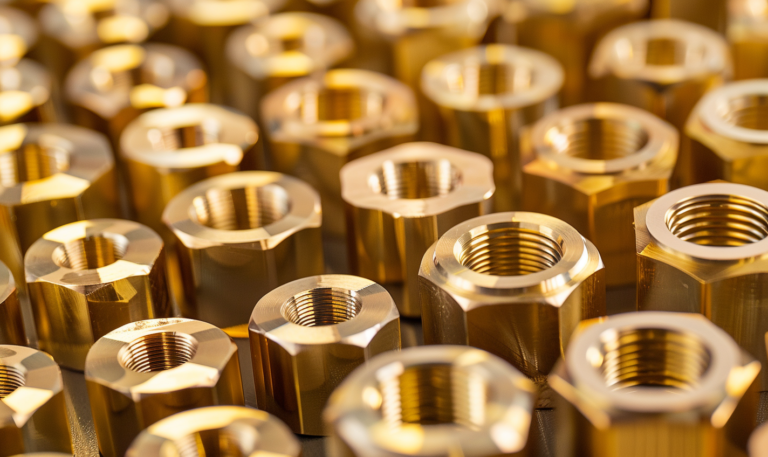In industries such as electronics, telecommunications, power systems, medical devices, and aerospace, precision fasteners are essential not only for mechanical connection and alignment but also for electrical conductivity, corrosion resistance, and stability in demanding environments. For applications requiring electrical and thermal conductivity, copper and copper alloys are often the preferred choice.
This article introduces the most commonly used copper materials for precision fasteners, including pure copper, brass, phosphor bronze, and beryllium copper. We analyze their performance characteristics, advantages, limitations, and application-specific recommendations to help you select the best copper alloy for fasteners in different use cases.
Why Choose Copper for Precision Fasteners?
Copper has unique material advantages that make it ideal for many precision fastening applications:
- Excellent electrical and thermal conductivity — second only to silver.
- Good corrosion resistance — particularly in water, atmosphere, and mild acids.
- High formability and machinability — ideal for precision turning, stamping, or cold forming.
- Stable mechanical properties and non-magnetic — suitable for high-frequency or EMC-sensitive environments.
However, not all copper alloys are the same. Below we compare the pros and cons of different copper materials commonly used in precision fasteners.
Common Copper Materials Used in Precision Fasteners
Ⅰ. Pure Copper (Red Copper / T2)
Overview:
- Purity ≥ 99.9%, usually electrolytic copper.
- Extremely high electrical conductivity (~58 MS/m), excellent for conductive components.
Pros:
- Outstanding electrical and thermal conductivity
- Excellent cold workability and deep drawing ability
- Good corrosion resistance in non-oxidizing environments
Cons:
- Low strength and hardness, not suitable for structural fasteners
- Surface oxidation and discoloration over time
- Higher cost compared to brass
Typical Applications:
- Signal connectors, grounding fasteners, RF terminals, low-current screw components
Ⅱ. Brass (H62, H65, HPb59-1)
Overview:
- Copper-zinc alloy; copper content typically 60–70%.
- Some grades include lead for improved machinability (e.g., HPb59-1).
Pros:
- Better strength than pure copper while maintaining good conductivity
- Excellent machinability and low cost
- Good corrosion resistance; easily electroplated or surface treated
Cons:
- Conductivity ~30–40% of pure copper
- Susceptible to dezincification in acidic or humid environments
- Limited thermal stability
Typical Applications:
- Electrical terminals, fastening inserts, connector screws, signal ports
Ⅲ. Phosphor Bronze (QSn6.5-0.1 / QSn4-0.3)
Overview:
- Copper-tin alloy with a small amount of phosphorus
- Known for its elasticity and corrosion resistance
Pros:
- Excellent elasticity and fatigue resistance
- Good wear resistance and dimensional stability
- Corrosion-resistant in marine, vapor, and harsh industrial environments
Cons:
- Lower electrical conductivity (~15–20% of copper)
- Higher material cost than brass
- Slightly more difficult to machine
Typical Applications:
- Spring washers, electrical contact screws, telecom terminal fasteners, precision connector hardware
Ⅳ. Beryllium Copper (QBe2 / C17200)
Overview:
- High-performance copper alloy with 1.8–2.0% beryllium
- Known for combining strength, conductivity, and elasticity
Pros:
- Extremely high strength and hardness (HRC38+ after heat treatment)
- Excellent fatigue and wear resistance
- Good electrical conductivity (~45–60% of copper)
- Non-magnetic and resistant to deformation under stress
Cons:
- Very expensive — the highest among all copper alloys
- Toxic beryllium content requires special processing precautions
- More difficult to machine and requires dust control
Typical Applications:
- Military-grade electrical screws, aerospace connectors, high-frequency contacts, high-end miniature fasteners
Ⅴ. Selection Guide: Choosing the Right Copper Material for Fasteners
To choose the appropriate copper material for precision fasteners, consider the following performance factors: conductivity, strength, corrosion resistance, elasticity, processability, and cost.
| Application Scenario | Recommended Material | Notes |
| High-frequency or signal connections | Pure Copper (T2) | Maximum conductivity; minimal structural stress |
| General-purpose electrical fasteners | Brass (H62, HPb59-1) | Best balance of machinability and cost |
| Spring-loaded or elastic fasteners | Phosphor Bronze | Ideal for cyclic loads and corrosion exposure |
| High-performance / aerospace / defense | Beryllium Copper | Top-tier strength and conductivity, higher cost |
Ⅵ. Surface Treatment Options for Copper Fasteners
Copper and copper alloys are prone to oxidation, which can degrade appearance and conductivity. Common surface treatments include:
- Nickel Plating – improves surface hardness and corrosion resistance
- Tin Plating – enhances solderability and conductivity
- Passivation – slows oxidation and surface discoloration
- Gold Plating – used in high-frequency, high-reliability components
Choosing the right surface finish is critical for achieving optimal performance and appearance.
Ⅶ. Summary: Copper Alloys for High-Performance Precision Fasteners
Thanks to their conductivity, machinability, and corrosion resistance, copper and copper alloys play a vital role in the development of high-performance precision fasteners. By selecting the appropriate copper grade, manufacturers can meet both functional and economic requirements — from simple signal screws to advanced aerospace connectors.
Each alloy offers distinct advantages, so the selection process should consider environmental conditions, electrical performance, mechanical demands, and surface finishing.


